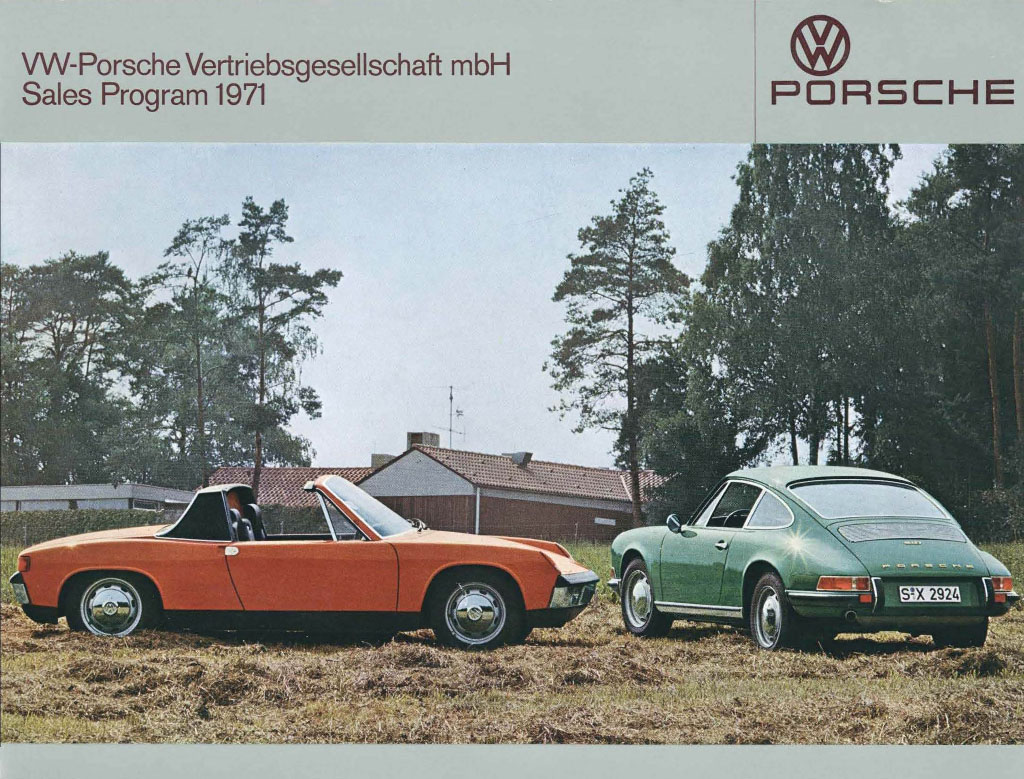
Porsche Press kit 1971 - landing page
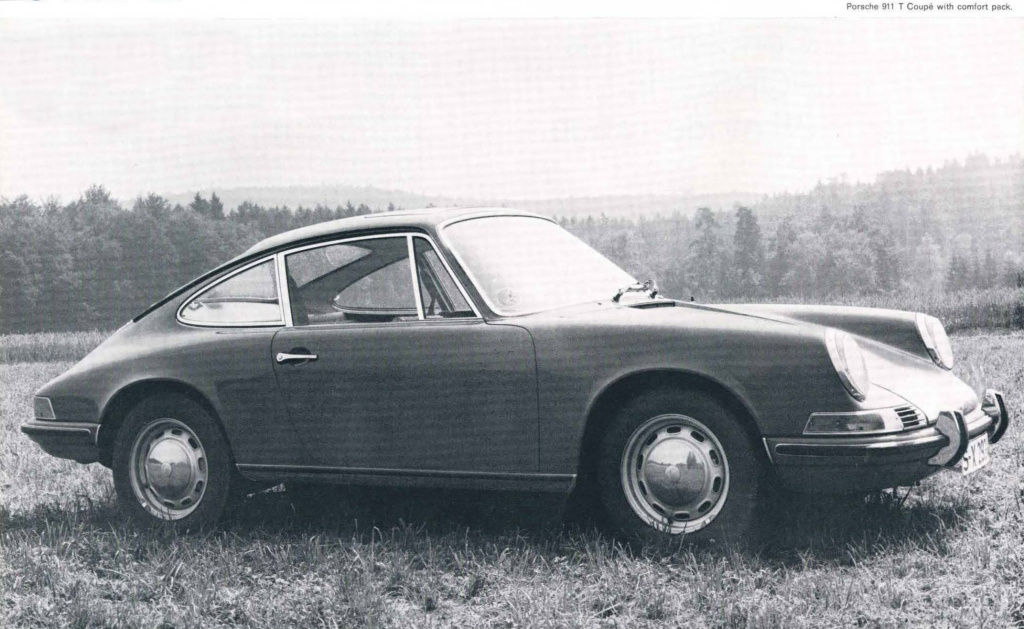
Vehicles in the 911 model range may be
considered as fast and luxurious touring
cars with a distinct sporting accent.
All three models share the same basic
technical conception. Location of the air
cooled horizontally opposed engines at the
rear provides the best possible compromise
between good aerodynamic form,
available space and the demands of safety
for the occupants. The dual circuit brake
system operating on ventilated discs at all
wheels, and the all-round independent
suspension are features which, like the
horizontally opposed six-cylinder engine
design, have withstood repeated arduous
tests in competition events.
The three models in the range, the 911 T, E
and S, cover the complete scale of available
equipment specifications and power
outputs, and are offered either with Coupe
body styling or as 'Targa' models for those
who prefer an open car.
The technical specification of any model
can be extended by a range of options;
from the wide selection available we would
draw special attention to the 'Sportomatic'
selective automatic transmission which
can be specified on the 911 T and 911 E
models.
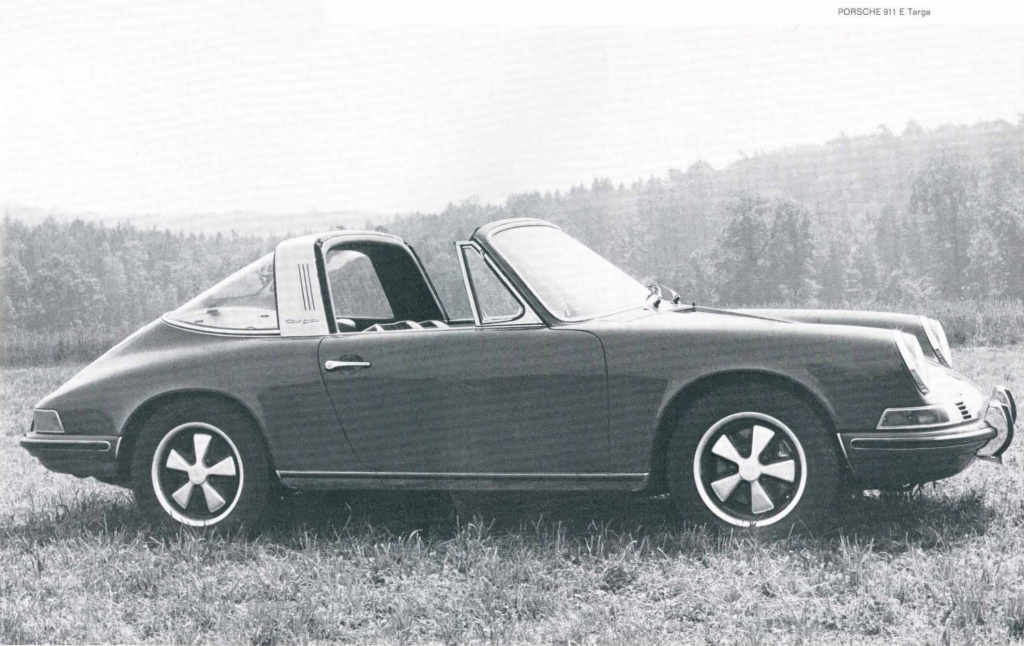
Vehicles in the 911 model range
feature the characteristic
Porsche streamlined styling.
This is not merely designed for
striking or fashionable effect,
but is governed by pure engineering
considerations. The
bodyshell, including the underside,
is as smooth as possible
for uninterrupted airflow, and
the resulting low drag coefficient
enables high road performance
to be obtained from
sensibly dimensioned and thus
economical power units.
The load bearing all-steel
bodyshell is welded to a frame
and floor panel assembly to
form a single unit.
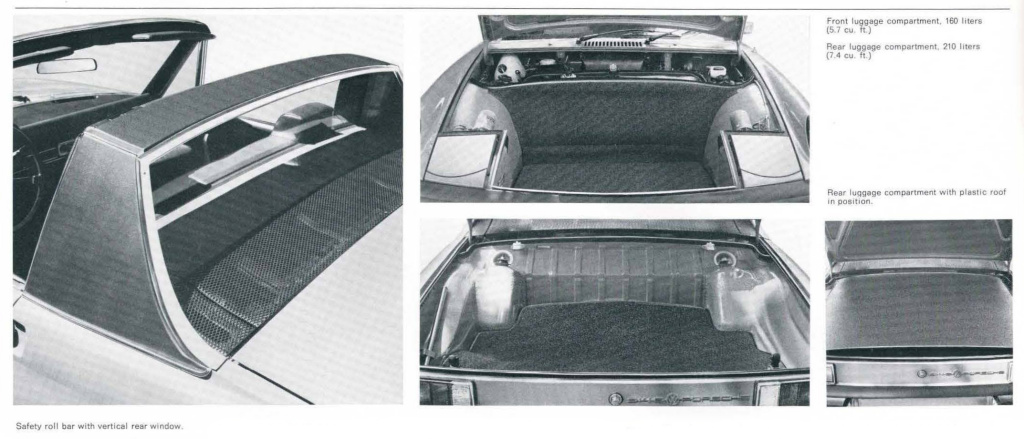
The high, domed windshield and the safety roll bar with vertical rear window ensure that the open car can be driven with a minimum of disturbing air currents and wind noise. In this way the VW-PORSCHE 914 models represent an ideal combination of the best features of a sports coupe and a convertible.
The low height of the mid engine enables the waistline to be kept low in turn. Electrically operated pop-up main headlamps form a harmonious continuation of the elegant lines. Additional halogen headlamps are installed as standard in the front bumper. Wide shaped rubber strips above the bumpers provide protection against minor damage when maneuvering and parking.
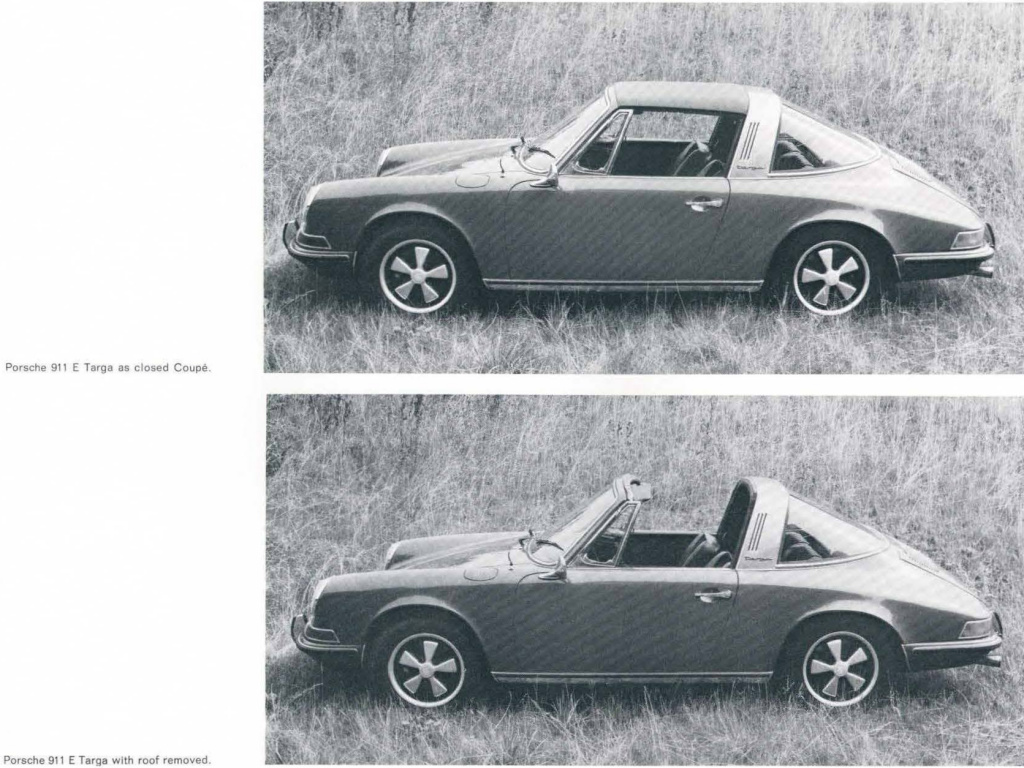
The passenger compartment
takes the form of a torsionally
rigid safety cell protected by
front and rear sections designed
to absorb impact energy.
The front fenders are bolted on
for ease of replacement, and
all electrical wiring, control
cables and linkage is fully enclosed
within the center tunnel
of the floor panel assembly.
The underbody leaves the
factory with full PVC underseal.
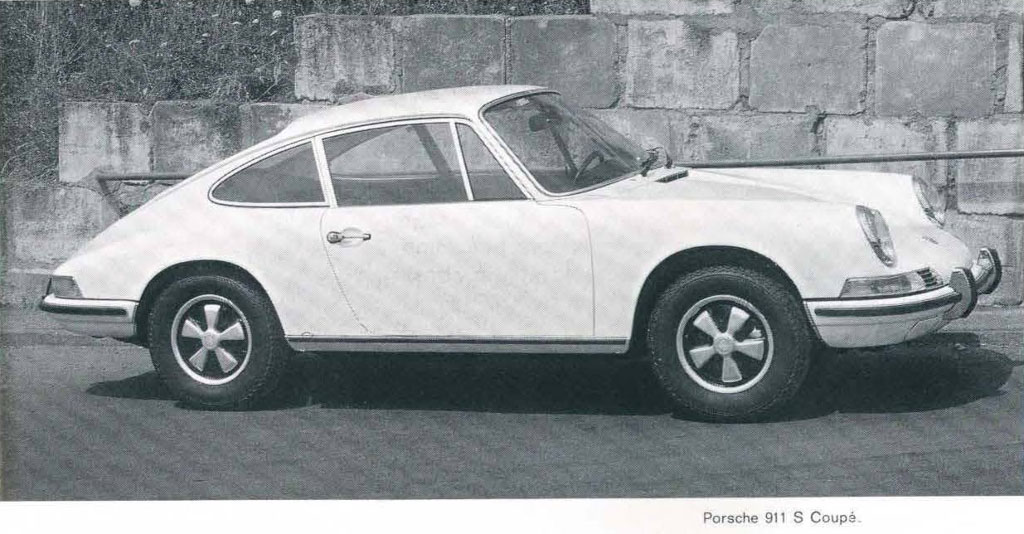
All 911 models are supplied
with laminated front windshield,
safety glass side and
rear windows, electrically
heated rear window, electric
windshield washer, halogen
headlamps, backup lights and
emergency hazard warning
flashers.
The open-top 'Targa' version
has a safety roll bar which cuts
downdrafts and wind noise
to a great extent.
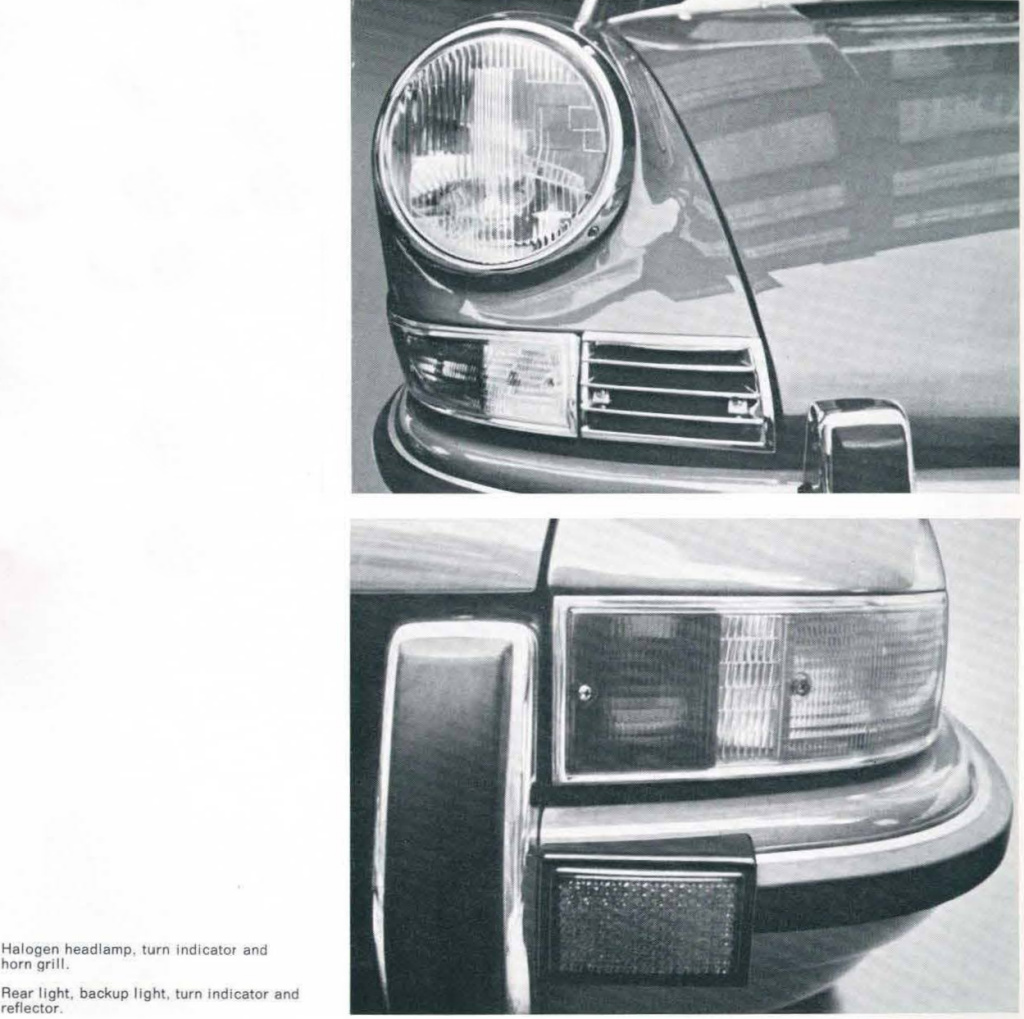
In contrast to last year's model program the standard equipment of the Porsche 911S is now similar to the Porsche 911E. The only major difference is the provision of sports seats as standard equipment.
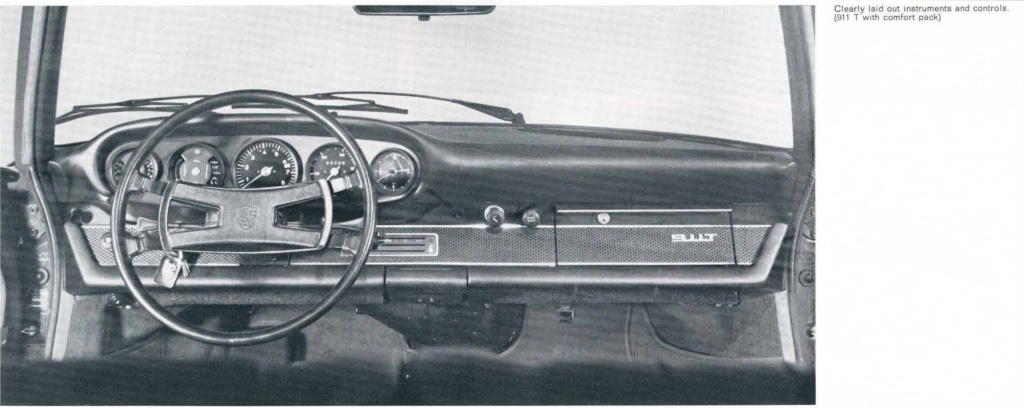
The layout of the interior and
the instrument panel on
PORSCHE 911 models, is
planned to meet the demand
for rapid, effortless operation
of all controls and easy reading
of the instruments.
All instrument dials are non glare,
and placed within the
driver's field of view. Without
removing his hands from the
steering wheel rim, the driver
can reach 2 combination switches
on the steering column
which operate the three-speed
wipers, windshield washer,
turn indicators, headlamp
flasher and high/low beam
headlamp switch.
The instrument panel comprises
tachometer, speedometer,
clock, fuel gauge, oil
thermometer, oil pressure
gauge (911 E and S) and oil
level indicator (911 E and S).
The non-glare dashboard is
padded on its upper and lower
edges.
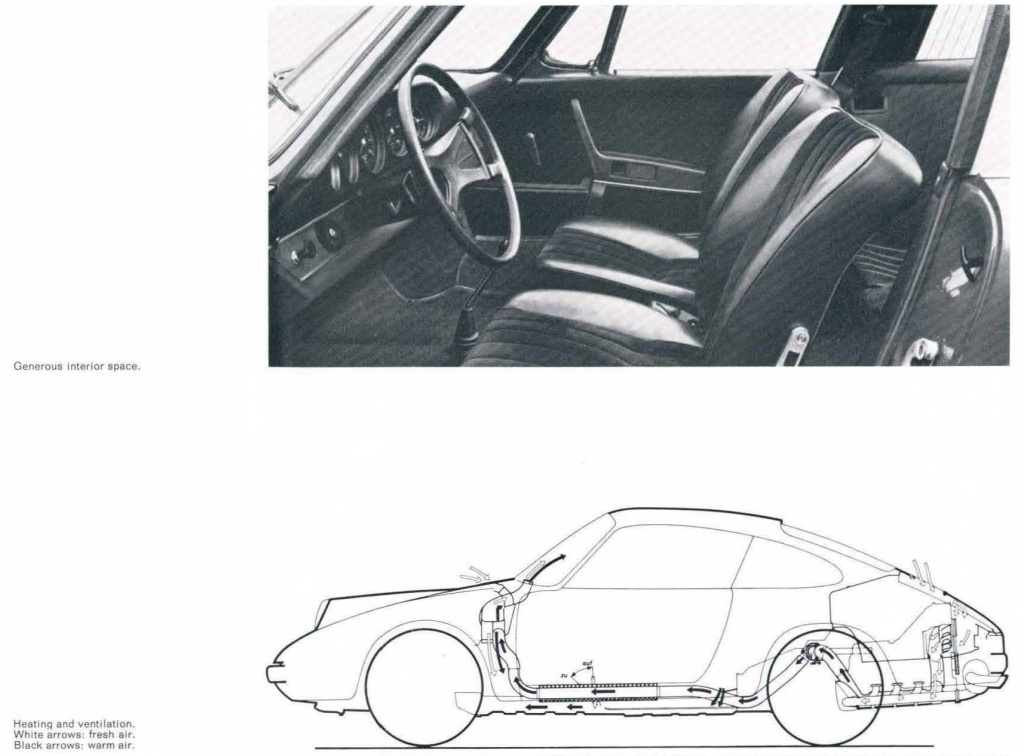
The passenger compartment
is of ample size to provide
both driver and passenger
with unrestricted freedom of
movement. On short journeys
additional seating accommodation
is provided by the rear
emergency seats. If the rear
seat backs are folded forward
a flat surface is obtained which
can be used to carry extra
items of luggage.
The front seats are of anatomically
correct pattern and are
mounted low down and close
to the car's center of gravity.
The 'bucket' type seats provide
the occupants with adequate
lateral support for fast
driving. Fore and aft seat
adjustment and seat back
angle variation ensure comfort
in a variety of driving positions
and allow the passenger to
relax on long journeys.
The specification includes seat
belt anchorages, a hand
throttle lever, draft-free ventilation
and stale air extraction
and separate continuously
variable heating and fresh air
systems with a three speed
blower.
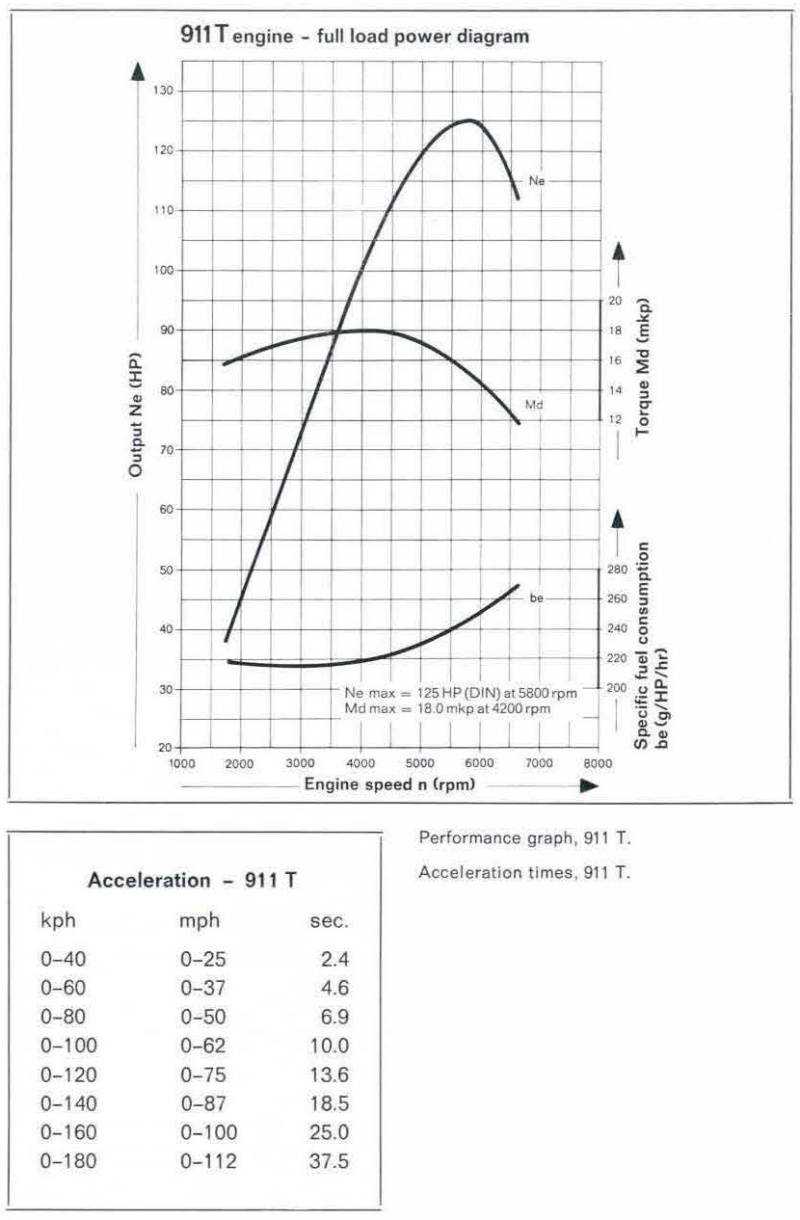
The 2.2 liter horizontally opposed engine of the 911 T develops 125 HP at 5800 rpm. The car's power-weight ratio is thus only 8.7 kg/HP (116.5 HP/ton), and no more than 10 seconds are needed to accelerate from 0 to 100 kph (62 mph). Maximum torque of 18 mkp (130.2 lb/ ft) is developed at 4200 rpm, and top speed is 205 kph (128 mph). The SPORTOMATIC selective automatic transmission can be supplied as an option, as well as the 5-speed gearbox.
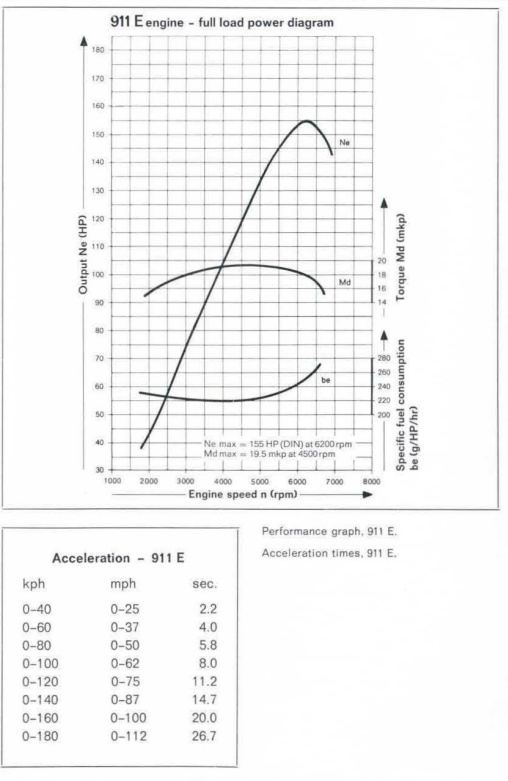
The Porsche 911 E can reach a top speed of 220 kph (137 mph). Maximum engine power of 155 HP is developed at 6200 rpm, and maximum torque, amounting to 19.5 mkp (140.5 lb/ ft), at 4500 rpm. With its power-weight ratio of only 6.9 kg/ HP (147.3 HP/ton) the 911 E can accelerate from 0 to 100 kph (0-62 mph) in 8 seconds. The standard 5-speed gearbox can be replaced if desired by the optional SPORTOMATIC selective automatic transmission.
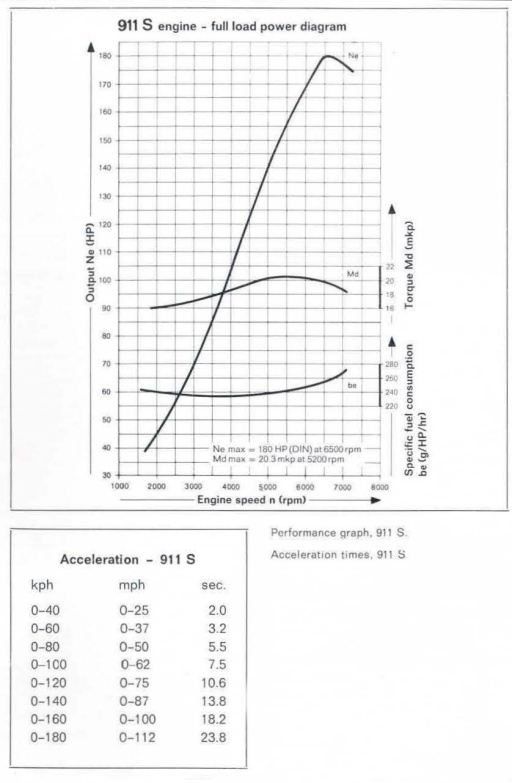
The 911 S has a 2.2 liter horizontally
opposed engine developing
180 HP at 6500 rpm.
Maximum torque of 20.3 mkp
(146.8 lb/ ft) is reached at 5200
rpm. The exceptionally high
power-weight ratio of 6.0 kg/
HP (169 HP/ton) results in
acceleration from 0-100 kph
(0-62mph) in only 7.5 seconds.
Top speed is 230 kph (143 mph).
Correctly chosen overall gear
ratios ensure that the top
speed can be maintained continuously
if so desired.
The 'E' power unit is designed
to develop its power at quite
low engine speeds, but the 'S'
engine does not reach maximum
output until the engine is
turning over much faster(about
5500 rpm). In other words, the
911 S engine is tuned to a
certain extent for competition
driving, whereas the 'E' power
unit has been designed for the
needs of day to day road use.
All six cylinder units, including
that installed in the VW-PORSCHE
914/6, have high
tension battery/capacitor ignition.
911 E and 911 S models
have the Porsche 5-speed
gearbox as standard, the 911 T
and E can be supplied with the
optional Porsche Sportomatic
transmission.
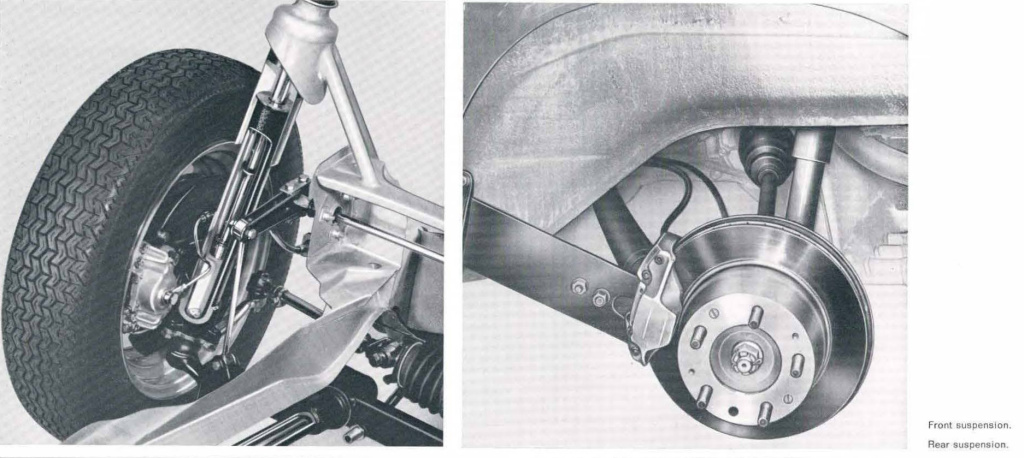
The chassis with its independent wheel suspension all round is also the same in principle on all PORSCHE 911 models. Detail technical modifications are made purely to suit the varying performance characteristics of each model.
The independently sprung front
wheels are located by lower
wishbones in conjunction with
shock absorber struts. The
springing medium is an adjustable
longitudinal torsion bar.
On the 911 E both springing
and damping functions are
carried out by a hydropneumatic
strut with automatic self leveling
action.
The 911 S is provided with an
anti-roll stabilizer.
The independently sprung
wheels are carried on semitrai
ling arms and suspended
on adjustable transverse torsion
bars. Damping is by
means of double acting hydraulic
shock absorbers.
Drive is taken to the rear
wheels through double universal
joint half shafts. All joints
are maintenance free. The
911 S has an additional anti roll
stabilizer.
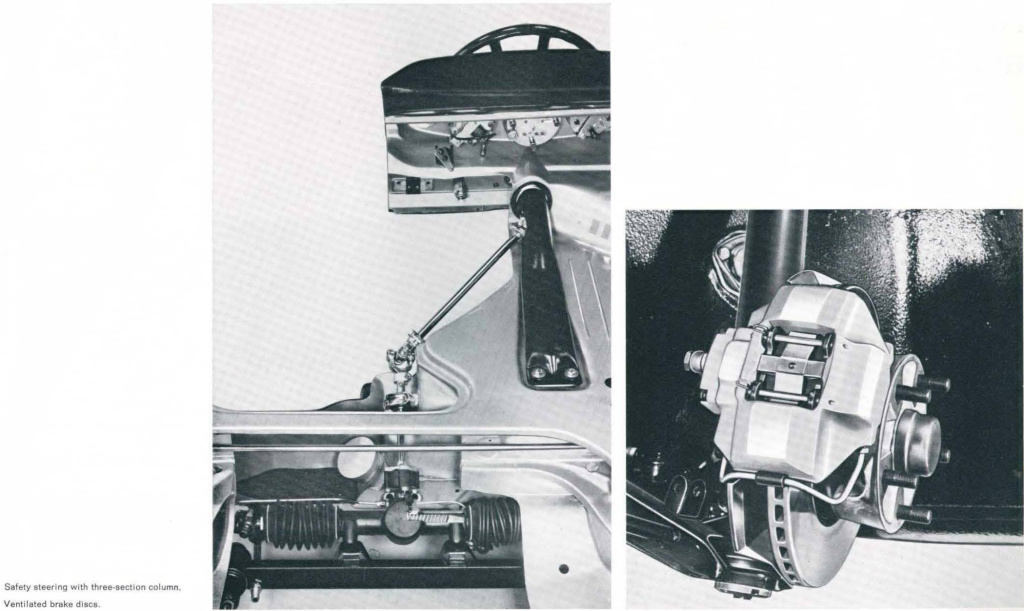
For reasons of safety the steering column of the rack and pinion steering gear is in three sections and cranked to provide impact protection. No-maintenance universal joints are used to connect the sections together. In conjunction with a four spoke steering wheel with recessed boss and large area padded horn push, the system offers the driver maximum possible collision protection.
All 911 models employ a dual circuit brake system operating on 4 ventilated brake discs. Automatic brake pad wear compensation is incorporated, and the handbrake operates separate drum brakes combined with the rear discs.
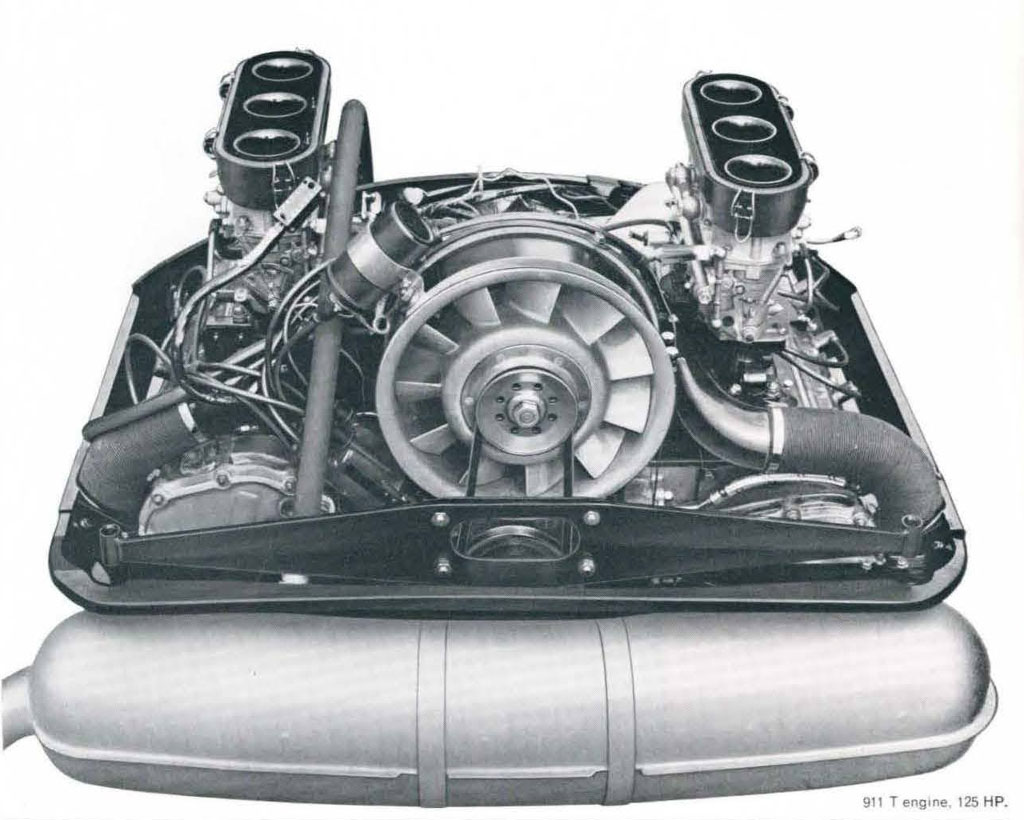
The air cooled six cylinder
power units installed in the 911
model range are of basically
identical engineering design,
but in contrast to the similar
unit used in the VW-Porsche
mid-engined sports car they
are installed behind the rear
axle rather than in front. This
makes greater interior space
available, so that 2 additional
emergency seats can be provided.
The six cylinders are
horizontally opposed in two
banks of three on either side
of the crankcase, and have
bolted-on heavily finned light
alloy heads. The overhead
valves are arranged in inverted
V pattern and operated by
rockers from a single overhead
camshaft on each cylinder
bank. The forged crankshaft
has eight main bearings.
Dry sump lubrication ensures
that all bearing points receive
a steady supply of oil even
during fast cornering. The
lubricating oil passes through
a full-flow filter and a thermostatically
controlled oil cooler.
The alternator and axial engine
cooling blower are driven by
Vee belt from the crankshaft.
Unlike the 911 E and S engines,
the 125 HP unit employed
in the 911 T has two triple
barrel downdraft carburetors
which supply mixture to the
engine through short intake
pipes. The relatively limited
output of this engine makes it
a willing and undemanding
power unit for this end of the
911 model range. Its power
output and torque curves are
smoother and less 'peaky' than
those of the other engine
types.
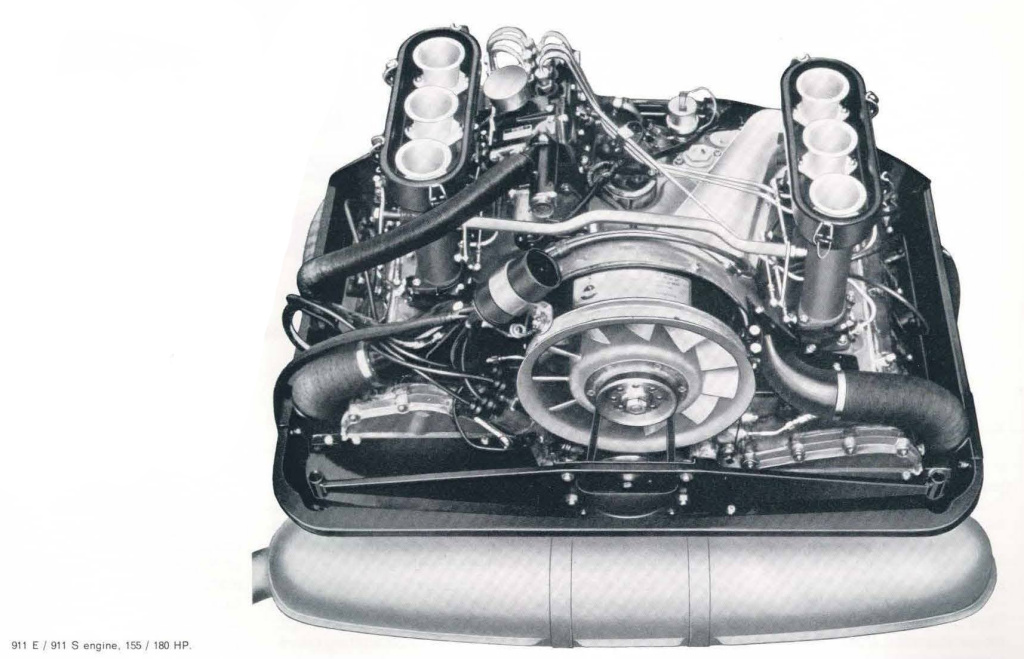
In contrast to the 911 T unit, the 911 E and S engines are supplied with fuel-air mixture by a mechanical manifold fuel injection system. In addition to the higher output of 155 HP (911 E) or 180 HP (911 S) thus made possible, the Bosch fuel injection system has the following advantages: reduced fuel consumption when the car is driven at varying speeds, better pulling power in all engine speed ranges and less sensitivity to changes in air temperature and pressure. The 911 S has in addition a second oil cooler.
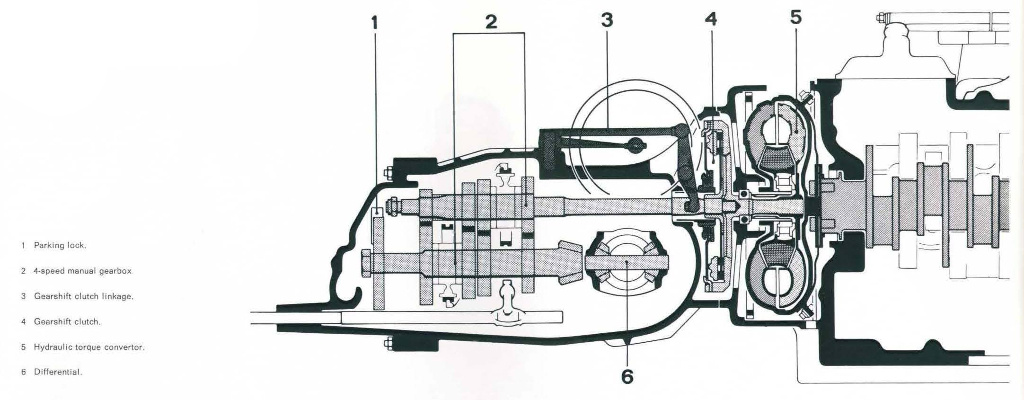
As an optional extra the standard
manual gearbox on the
911 T, 911 E and 914/6
models can be replaced by the
Porsche Sportomatic transmission.
This selective automatic transmission
enables the driver to
shift gears as and when he
likes. But gear shifts are no
longer essential. When forced
to 'swim with the stream' in
heavy traffic no advantage is
gained from continual operation
of the gear lever, and in
the long run gear shifting can
become tedious in such situations.
The Sportomatic transmission
combines two well
known and tested design principles:
a modern hydrodynamic
drive train, usually referred
to as a hydraulic torque convertor, and the Porsche all synchromesh
four speed gearbox
with parking lock. The
torque convertor operates as
a starting clutch, provides continuously
varying torque multiplication
of the force transmitted
by the engine, and thus
adapts itself automatically to
any driving situation. The shift
clutch necessary to interrupt
the drive when shifting gears
also disengages automatically
as soon as the driver starts to
move the gear lever.
The high efficiency of the
hydraulic torque convertor, in
conjunction with the fast gear
shifts possible with the Sportomatic,
enable almost the same
road performance to be achieved
as in a Porsche with conventional
clutch and gearbox.
The Sportomatic shows its
superiority in heavy traffic,
when hill climbing and on icy
roads, where accidental or
uncontrolled jerking movements
when gear shifting or
surges of power at the rear
wheels can be quite dangerous.
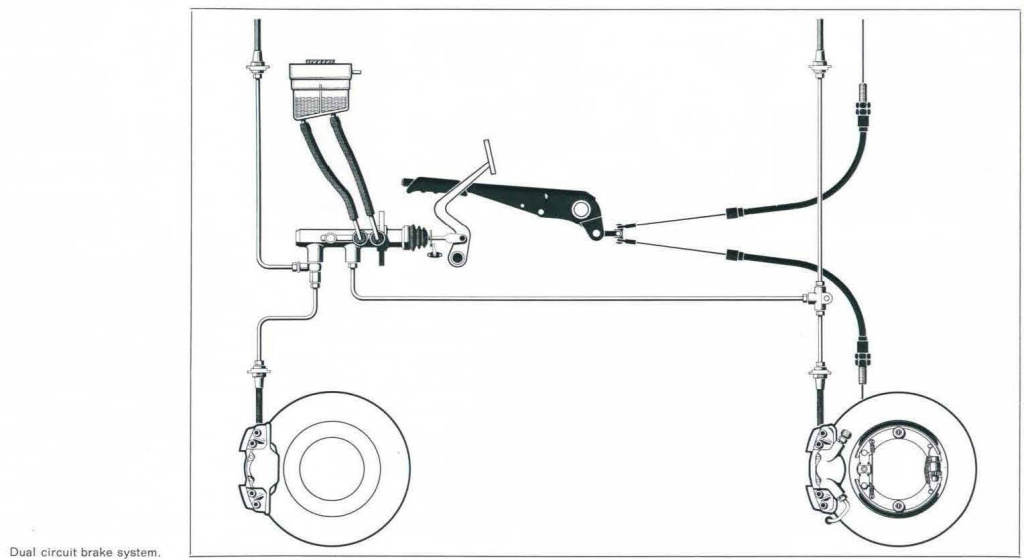
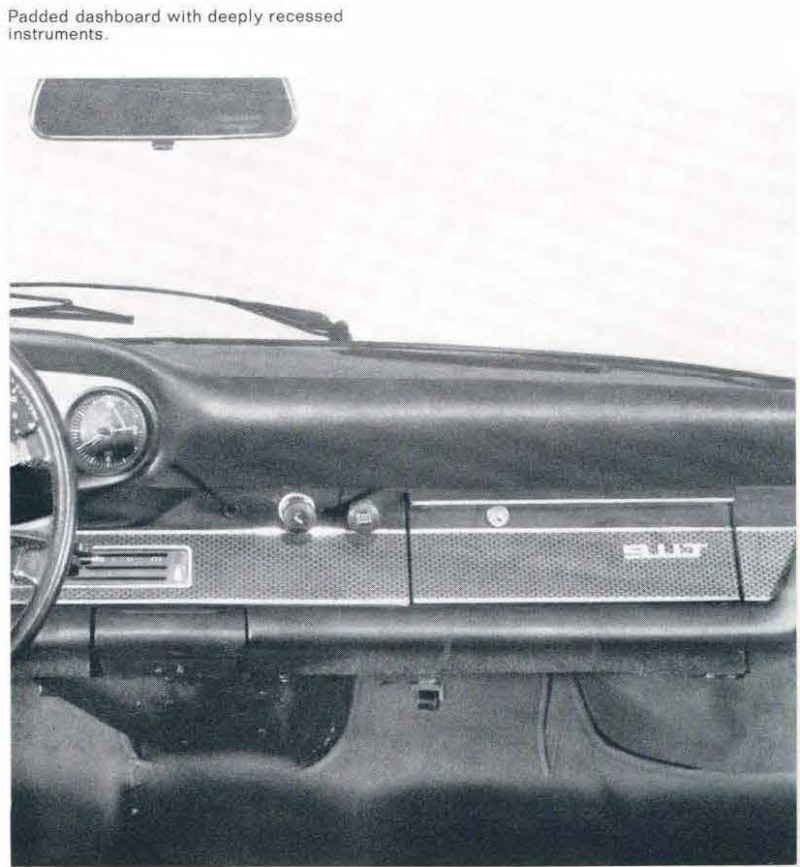
Numerous measures to reduce
the after-effects of an accident
have be introduced on the 911
model range:
Impact energy is to a large
extent absorbed directly by
the all-steel bodyshell. This
is fully self-supporting and
encloses the rigid central
passenger compartment. The
front section, in contrast, comprises
a crushable energy absorbing
zone. On the 'Targa'
versions the safety roll bar
ensures that rigidity and occupant
safety is just as high as
on the Coupe. It is worth mentioning
that the emergency
hazard warning system has
separate circuits for the front
and rear flashers, so that in the
event of a nose to tail collision
damaging one end of the car
the flashers at the other end
continue to function.
To protect the driver and occupants
the designers of the 911
range have provided a three piece
cranked steering column,
a steering wheel with
recessed boss, a padded dashboard
with deeply recessed
instruments, smooth surfaced
padded or flexible control
knobs and a laminated safety
glass front windshield.
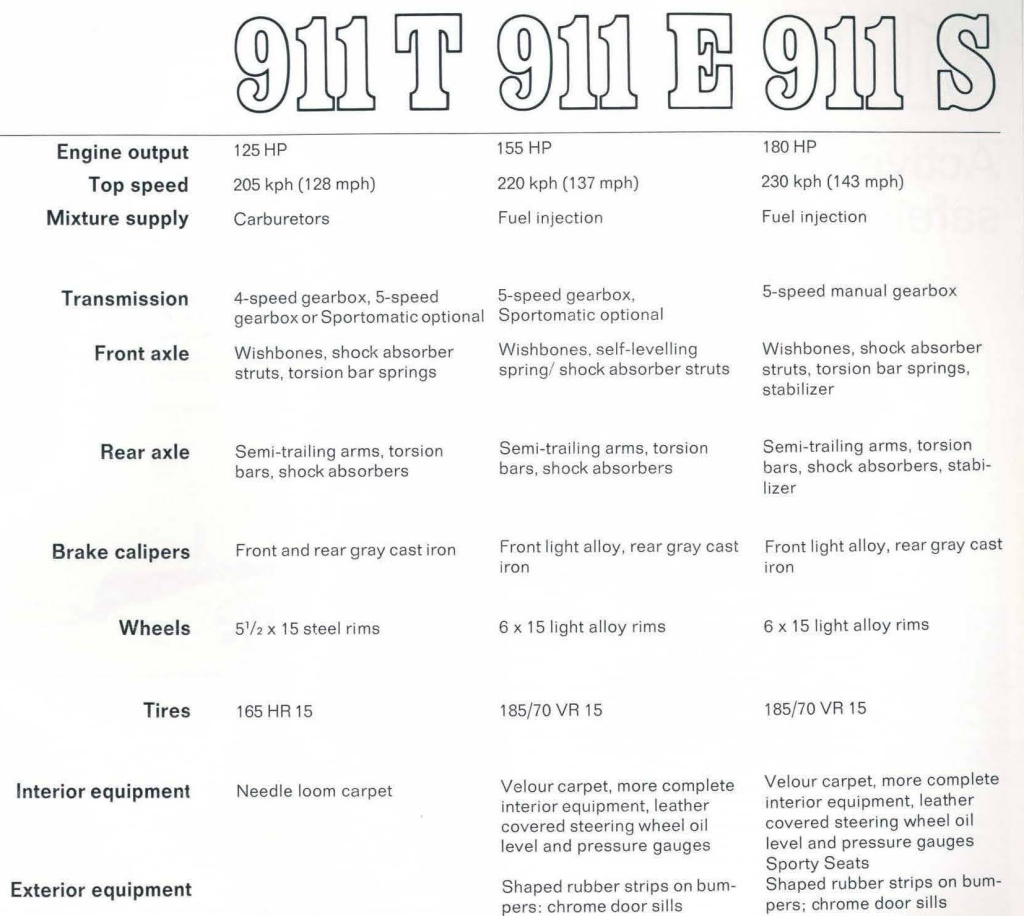
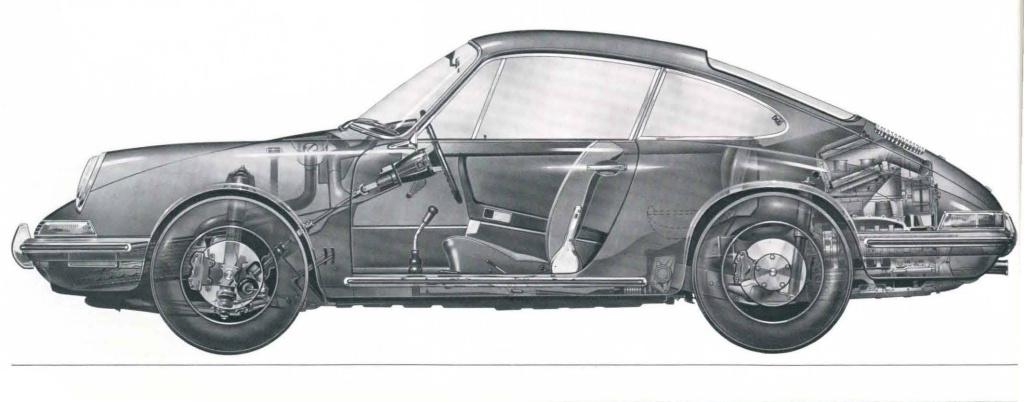
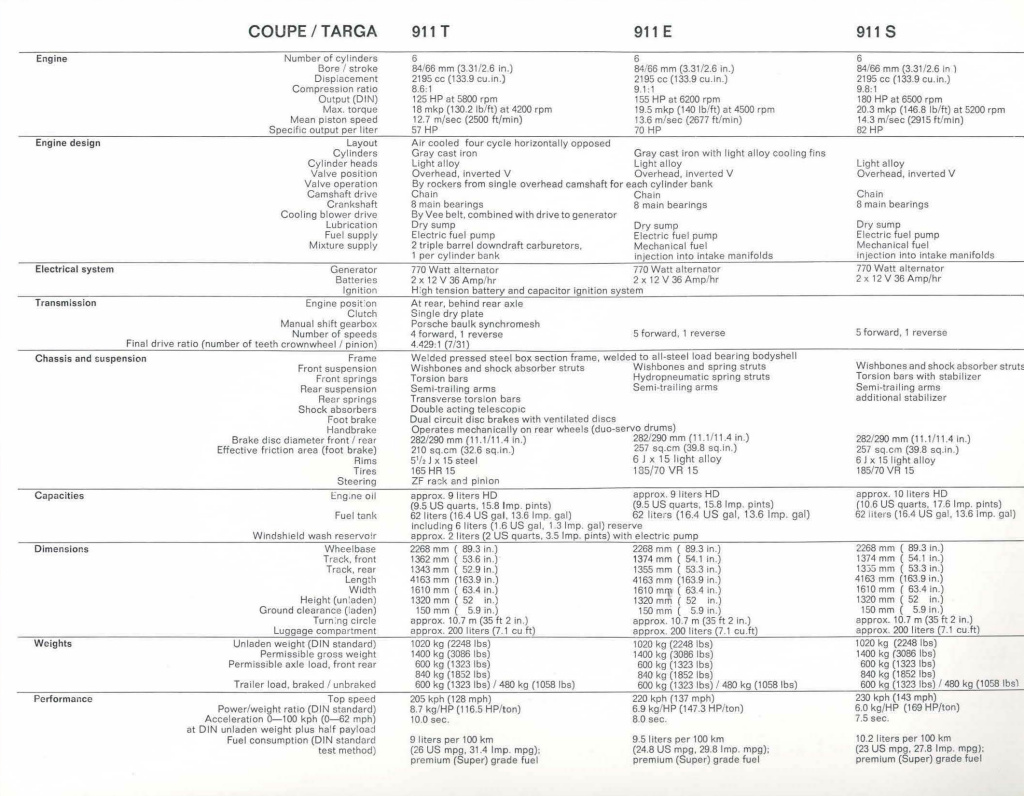


Porsche Press kit 1971 - landing page
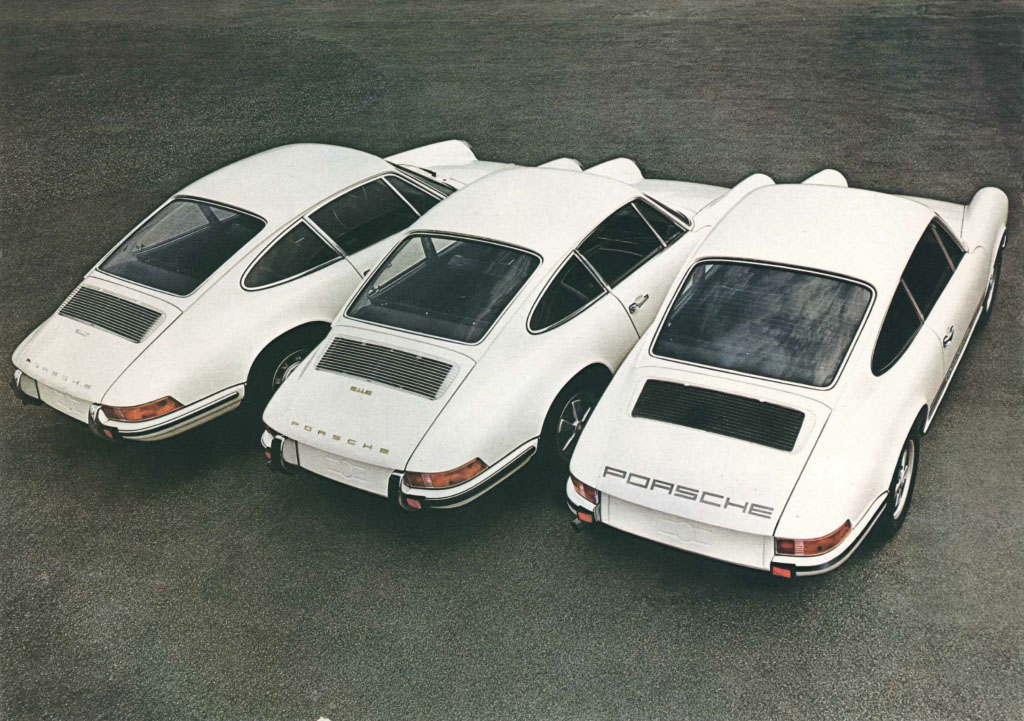
PORSCHE PRESS KIT 1970 - 911 T, E and S
.jpg)
PORSCHE PRESS KIT 1972 - 911

Porsche Press kit

Porsche Literature

Our Porsche Cars